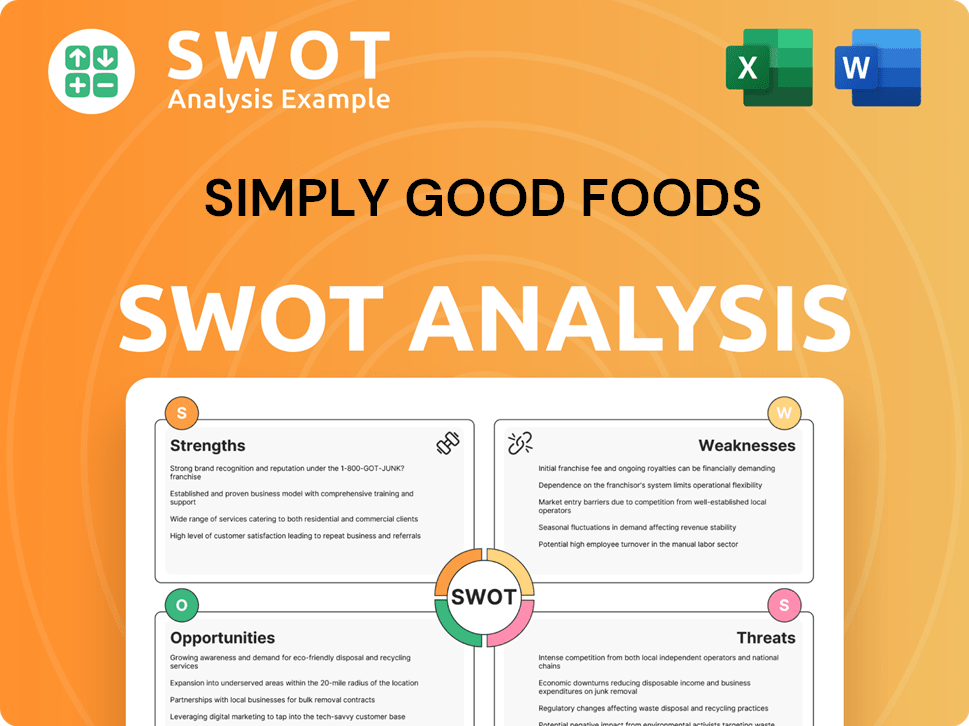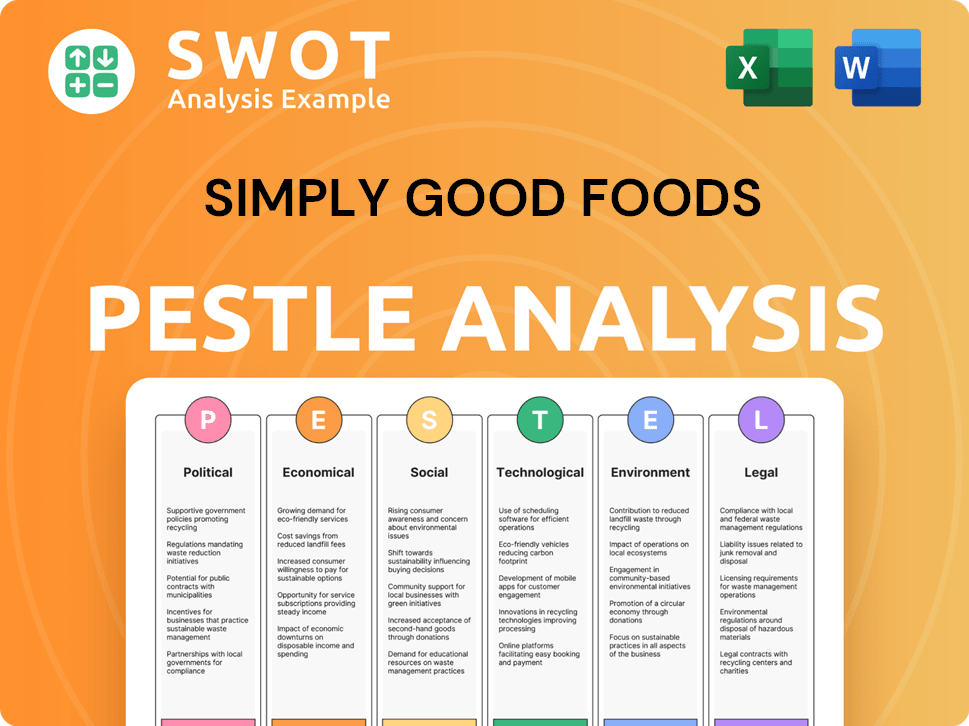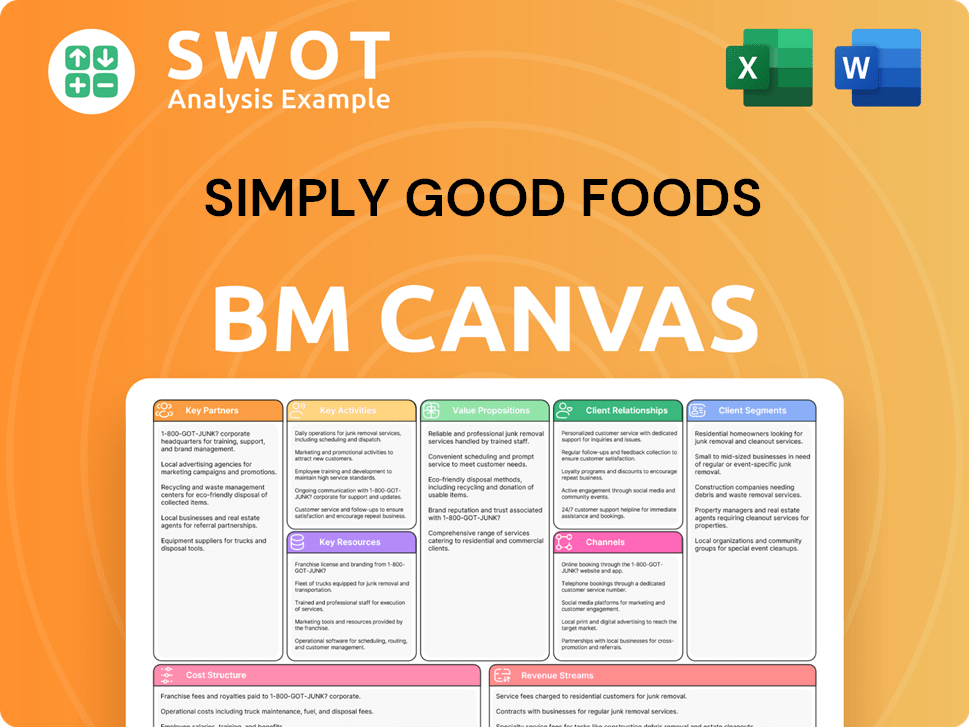Simply Good Foods Bundle
Who Buys Simply Good Foods Products?
In a market overflowing with choices, understanding the Simply Good Foods SWOT Analysis is crucial: who are the consumers driving the success of brands like Atkins and Quest? What are their needs, and how does Simply Good Foods tailor its approach to meet them? Delving into the customer demographics and target market of Simply Good Foods Company reveals a fascinating story of adaptation and strategic growth in the nutritional snacking industry.

By examining the consumer profile of both Atkins and Quest, we can uncover the core market segmentation strategies that have propelled Simply Good Foods forward. This analysis will explore the evolving landscape of nutritional products and how the company continues to refine its offerings to resonate with its audience. This comprehensive look at Simply Good Foods Company provides valuable insights for anyone interested in the food and beverage industry.
Who Are Simply Good Foods’s Main Customers?
Understanding the Customer demographics and target market of Simply Good Foods Company is crucial for evaluating its market position and growth potential. The company, focused on the nutritional snacking market, caters primarily to consumers (B2C). Its success hinges on effectively reaching and retaining its diverse customer base, which includes individuals with varying needs and preferences regarding nutritional products.
The Simply Good Foods Company has two main brands, each targeting different segments. Historically, the Atkins brand focused on weight management and low-carbohydrate diets, attracting an older demographic. In contrast, the Quest brand targets a younger, more active audience prioritizing high protein and low sugar in their snacks. This dual-brand strategy allows Simply Good Foods Company to capture a wider range of consumers within the health and wellness space.
The company's approach to market segmentation is dynamic, adapting to evolving consumer trends. The shift towards a 'better-for-you' snacking philosophy indicates a broader appeal beyond strict dietary regimens. This strategy is supported by market research, demonstrating a growing demand for healthier snack options among mainstream consumers.
Atkins products historically targeted an older demographic, typically aged 35-65+, focused on weight management and low-carb diets. This segment often includes individuals with higher disposable incomes. The brand's focus on structured dietary solutions appeals to those seeking a disciplined approach to nutrition.
Quest Nutrition largely caters to a younger, more active demographic, typically aged 18-45. This group comprises fitness enthusiasts, athletes, and health-conscious individuals. They prioritize high protein and low sugar content in their snacks and are often engaged with social media and digital health trends.
Simply Good Foods Company employs market segmentation strategies to cater to different consumer needs. This includes brand-specific targeting and a broader 'better-for-you' approach to appeal to a wider audience. The company uses market research to identify and respond to evolving consumer preferences, ensuring its products remain relevant and competitive. The company's ability to adapt its target market is crucial for long-term success.
The consumer profile for Simply Good Foods Company varies by brand. Atkins customers often seek structured dietary solutions for weight management, while Quest customers prioritize high protein and low sugar for active lifestyles. Understanding these distinct consumer profiles allows the company to tailor its product offerings and marketing efforts effectively. The company is constantly adapting to changing consumer needs.
Simply Good Foods Company targets distinct customer segments with its Atkins and Quest brands, adapting to changing consumer preferences. The company's focus on nutritional snacking caters to a broad audience. Understanding the customer demographics is essential for strategic planning.
- Atkins targets an older demographic focused on weight management, while Quest appeals to a younger, active audience.
- The company is expanding its target segments beyond strict diet adherence to a 'better-for-you' philosophy.
- Market research and brand positioning are crucial for reaching the appropriate consumer base.
- For more information on how the company generates revenue, see Revenue Streams & Business Model of Simply Good Foods.
Simply Good Foods SWOT Analysis
- Complete SWOT Breakdown
- Fully Customizable
- Editable in Excel & Word
- Professional Formatting
- Investor-Ready Format

What Do Simply Good Foods’s Customers Want?
Understanding the customer needs and preferences is crucial for the success of the Simply Good Foods Company. The company's success hinges on its ability to cater to specific dietary needs and lifestyle choices. This involves providing convenient, tasty, and nutritionally beneficial products that resonate with their target market.
The Simply Good Foods Company's strategy focuses on two primary consumer groups: those following the Atkins diet and those seeking high-protein, low-sugar options like Quest Nutrition. These groups share a common desire for great taste, convenience, and products that align with their health goals. The company tailors its product development and marketing to meet the unique needs of each segment.
The company's approach is rooted in continuous adaptation to consumer feedback and market trends. This includes introducing new flavors, formats, and product lines to meet evolving preferences. By understanding and responding to these needs, the Simply Good Foods Company aims to maintain customer loyalty and drive growth in the competitive nutritional products market.
The primary drivers for Atkins consumers are weight management, blood sugar control, and adherence to a low-carbohydrate lifestyle. They prioritize products that fit their dietary requirements without sacrificing flavor. Purchasing behaviors are often driven by product efficacy in supporting their health goals.
Quest consumers focus on high protein, low sugar, and clean ingredients to support active lifestyles and muscle recovery. They often look for products that can serve as meal replacements or performance-enhancing snacks. These consumers are often fitness-oriented and seek convenient, healthy options.
Both segments share a common desire for great taste, which is a significant loyalty factor in the competitive snacking market. Convenience is also a key factor, as consumers seek easy-to-consume, healthy options. The company addresses common pain points such as the difficulty of finding convenient, healthy, and tasty snack options.
Customer feedback and market trends continually influence product development. The company has tailored its marketing to highlight the 'net carbs' for Atkins products, appealing directly to their target audience's dietary focus. Quest's marketing emphasizes protein content and functional benefits.
The company's marketing strategies are tailored to each segment. For Atkins, the focus is on low-carb benefits, while Quest emphasizes high protein and functional advantages. The introduction of new flavors and formats, such as Quest Loaded Protein Chips, caters to evolving consumer preferences.
The company adapts to changing consumer demands, such as the growing interest in plant-based options and allergen-free products. This flexibility ensures the Simply Good Foods Company remains relevant and competitive in the nutritional products market. For more insights, check out the Marketing Strategy of Simply Good Foods.
The Simply Good Foods Company focuses on meeting specific needs within its target market. These needs include weight management, blood sugar control, and adherence to low-carbohydrate diets for Atkins consumers. Quest consumers prioritize high protein and low sugar for active lifestyles. Both segments value great taste and convenience.
- Weight Management: A primary driver for Atkins consumers, reflected in product formulations and marketing.
- High Protein: A key preference for Quest consumers, influencing product development and branding.
- Convenience: Essential for both segments, with products designed for easy consumption and integration into busy lifestyles.
- Taste: A critical factor in customer loyalty, with the company investing in flavorful product options.
- Nutritional Benefits: Products are designed to meet specific dietary needs and health goals, such as low-carb or high-protein intake.
Simply Good Foods PESTLE Analysis
- Covers All 6 PESTLE Categories
- No Research Needed – Save Hours of Work
- Built by Experts, Trusted by Consultants
- Instant Download, Ready to Use
- 100% Editable, Fully Customizable

Where does Simply Good Foods operate?
The Simply Good Foods Company primarily focuses its market presence within North America. This includes a strong emphasis on the United States and Canada, where the company has established significant brand recognition and market share for its Atkins and Quest product lines. The strategic focus remains on solidifying its position within these key regions.
Within the United States and Canada, the company's products are widely available across various retail channels. These include grocery stores, mass merchandisers, club stores, drug stores, and e-commerce platforms. This multi-channel distribution strategy ensures broad accessibility for consumers interested in their nutritional products.
While the core market remains North America, the company has explored international expansion opportunities. However, the primary focus has historically been on strengthening its presence in existing markets. This approach allows for targeted marketing and distribution strategies tailored to specific regional consumer preferences.
The company's geographical market presence is centered on North America, specifically the United States and Canada. This focus allows for efficient resource allocation and targeted marketing efforts. This is a key aspect of their Brief History of Simply Good Foods.
Products are distributed through diverse retail channels, including grocery stores, mass merchandisers, and e-commerce platforms. This multi-channel approach ensures broad consumer reach and accessibility. The company leverages strong retail partnerships for effective distribution.
Marketing and distribution strategies are tailored to regional consumer habits and retail landscapes. This includes variations in product availability and promotional activities. Adapting to local environments is crucial for market penetration.
While North America is the primary focus, the company has explored international expansion opportunities. However, the emphasis remains on solidifying its position in established markets. Strategic decisions are driven by market potential.
The company's market approach is influenced by various factors. Understanding the customer demographics, consumer profile, and market segmentation is essential. Here are key considerations:
- Customer demographics research helps define the target market.
- Market segmentation strategies are tailored to specific consumer groups.
- Brand positioning is aligned with the target market's needs.
- The company employs customer acquisition strategies to reach its target market.
Simply Good Foods Business Model Canvas
- Complete 9-Block Business Model Canvas
- Effortlessly Communicate Your Business Strategy
- Investor-Ready BMC Format
- 100% Editable and Customizable
- Clear and Structured Layout

How Does Simply Good Foods Win & Keep Customers?
Simply Good Foods Company focuses on both acquiring and retaining customers through a blend of digital and traditional marketing. Digital strategies, like social media campaigns and influencer partnerships, are key to reaching health-conscious consumers. Traditional methods, including in-store promotions, support broader brand awareness. The company leverages its e-commerce platforms to engage directly with consumers, gathering valuable data to refine its strategies.
Sales tactics include promotional pricing and strategic product placement to drive sales. Customer loyalty, though not through traditional programs, is fostered through consistent product innovation and high-quality offerings that meet specific nutritional needs. Data analytics and CRM systems enable personalized marketing, tailoring messages and recommendations based on consumer preferences. The company continually adapts by expanding product lines and leveraging new social media platforms.
The effectiveness of acquisition campaigns is often measured by increased sales volume and market share, while retention is gauged by repeat purchases and customer lifetime value. Understanding the Growth Strategy of Simply Good Foods helps to provide a comprehensive view of their approach.
Digital marketing is crucial for reaching the target market. This includes social media campaigns, influencer collaborations, and targeted online advertising. These efforts help in reaching health-conscious consumers and those interested in nutritional products.
Traditional marketing methods support broader brand awareness. This includes in-store promotions and advertising to drive impulse purchases in retail environments. These tactics help to increase visibility and encourage trial of the products.
E-commerce platforms are used for direct consumer engagement. They gather valuable data on consumer behavior and preferences. This data is used to personalize marketing messages and product recommendations.
Sales tactics involve promotional pricing and strategic product placement. Bundled offers and maximizing visibility in retail stores are also used. These strategies encourage trial and boost sales.
Customer loyalty is built through consistent product innovation. Maintaining high-quality, great-tasting offerings that meet specific nutritional needs is crucial. Personalized experiences are facilitated through data analytics and CRM systems.
- Market Segmentation: The company uses market segmentation to target specific consumer groups.
- Consumer Profile: Understanding the consumer profile helps tailor products and marketing efforts.
- Customer Demographics: Analyzing customer demographics is vital for effective marketing.
- Target Market: Identifying and reaching the target market is a key focus.
Simply Good Foods Porter's Five Forces Analysis
- Covers All 5 Competitive Forces in Detail
- Structured for Consultants, Students, and Founders
- 100% Editable in Microsoft Word & Excel
- Instant Digital Download – Use Immediately
- Compatible with Mac & PC – Fully Unlocked

Related Blogs
- What are Mission Vision & Core Values of Simply Good Foods Company?
- What is Competitive Landscape of Simply Good Foods Company?
- What is Growth Strategy and Future Prospects of Simply Good Foods Company?
- How Does Simply Good Foods Company Work?
- What is Sales and Marketing Strategy of Simply Good Foods Company?
- What is Brief History of Simply Good Foods Company?
- Who Owns Simply Good Foods Company?
Disclaimer
All information, articles, and product details provided on this website are for general informational and educational purposes only. We do not claim any ownership over, nor do we intend to infringe upon, any trademarks, copyrights, logos, brand names, or other intellectual property mentioned or depicted on this site. Such intellectual property remains the property of its respective owners, and any references here are made solely for identification or informational purposes, without implying any affiliation, endorsement, or partnership.
We make no representations or warranties, express or implied, regarding the accuracy, completeness, or suitability of any content or products presented. Nothing on this website should be construed as legal, tax, investment, financial, medical, or other professional advice. In addition, no part of this site—including articles or product references—constitutes a solicitation, recommendation, endorsement, advertisement, or offer to buy or sell any securities, franchises, or other financial instruments, particularly in jurisdictions where such activity would be unlawful.
All content is of a general nature and may not address the specific circumstances of any individual or entity. It is not a substitute for professional advice or services. Any actions you take based on the information provided here are strictly at your own risk. You accept full responsibility for any decisions or outcomes arising from your use of this website and agree to release us from any liability in connection with your use of, or reliance upon, the content or products found herein.